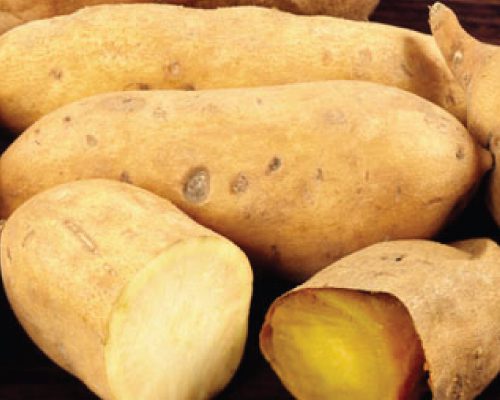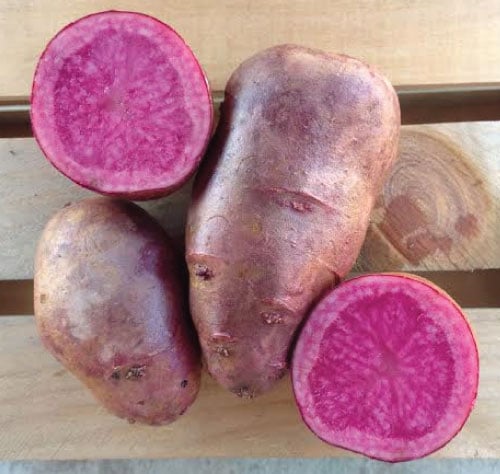
Learning Download: How to Grow Seed Potatoes
From Seed to Harvest: A guide to growing seed potatoes.
Potatoes are an excellent carb source and culinary staple that can be added to roasts, stews or as an addition to a meal. They come in various colors and shapes, such as the traditional Yukon gold to purple fingerling potatoes. Potatoes can be grown from true seed or seed potatoes, which are pieces of a cut-up potato.
What potatoes to use for seed potatoes?
Although potatoes purchased from the grocery store will sprout and go to seed, it is best to buy the seed potatoes from a certified grower, as starting with quality seed potatoes. Also, sometimes potatoes purchased from a supermarket are treated with growth retardant or contain harmful pathogens that can harm the growth of a new plant. Seed potatoes should be clear of blemishes or brown spots, and the skin should not be split or bumpy.
How to cut seed potatoes:
Seed potatoes should have at least one or two sprouts, or eyes, on them, and larger potatoes with three or more sprouts can be cut in half. Cut seed potatoes in 1-inch pieces. Once the seed potatoes have been cut, give them enough time to callous, generally 10 to 14 days. If the seed potatoes haven’t healed prior to planting, the wetness of spring can cause them to rot. To quicken the healing process of freshly cut seed potatoes, you can apply sulfur to the flesh. Sprinkle the sulfur onto the cut potatoes and lay the potatoes out in a single layer in a warm, humid location to dry for a few days. Most often, a paper bag is used to hold the potatoes with the top of the bag then folded over. Fingerling potatoes are often planted whole, as seed potatoes do not need to be cut if they have only one or two eyes.
How much seed potato do I need?
Seed potatoes can be planted for two purposes – to be grown and harvested as adult potatoes or to be harvested when they are young for new potatoes. To determine how much seed potato you need to plant, measure the length of the rows you plan to plant the seed potatoes in. If planting multiple rows, add the lengths together. Divide that final number by 10 to determine the amount of seed potatoes you will need in pounds. On average, 1 pound of seed potatoes plants 10 feet of potatoes. If planning to harvest the potatoes when they are young, increase the amount of seed potatoes to 1.5 pounds per 10 feet.
To plant:
Seed potatoes can be planted up to four weeks before the last frost date. Plant with the eye facing up in a trench dug about 4 inches deep. Space the potatoes 10-12 inches apart.
To grow:
Potatoes like acidic soil with a pH of 5.2. Once plants reach 6 inches tall but before they begin to flower, gardeners should start the hilling process. This helps prevent potato sunburn, which creates a chemical called solanine that turns the potato green. Solanine is toxic, so do not eat green potatoes. Hilling the soil up around the base of the plant prevent sunburn. Hilling covers the root and also adds support to the plant. This process needs to be done every few weeks throughout the potato’s growing season.
To harvest:
Potatoes are ready to harvest when the foliage begins to die back. Once this happens, cut the brown foliage off and leave the potatoes for 10 to 14 more days. Dig up the potatoes on a dry day but handle them gently as they bruise easily. Once harvested, store the potatoes in a cool, dark place for two weeks to allow for the skin to cure. Curing the skin allows for the potatoes to keep longer. Once cured, do not store potatoes near apples, as the apples make the potatoes go bad.
What potatoes crave:
Potatoes crave nitrogen and phosphorous. Prior to planting, non-organic gardeners can use a standard 15-15-15 fertilizer and work it into the soil’s surface. To aid in potato growth, side dress freshly sprouted seeds with a mix of cottonseed meal, bone meal and greenmeal to increase the soil’s acidity. You can also add in kelp meal.
During the growing season, feed the plants with fish emulsion or kelp extract every two weeks until the plants bloom. Then, six weeks after planting, side dress the potatoes with the same fertilizer mix used at planting but only half as much.
Where to buy seed potatoes:
You can find a variety of seed potatoes at Urban Farmer.

Learning Download: Common pests and diseases: Potatoes
Common pests and diseases: Potatoes
When growing vegetables, it is always exciting to care for the plant throughout its growing phase and then harvest it for delicious recipes later on, but one thing to watch out for is pests and diseases. Different plants are susceptible to different types of pests and diseases, and it is important to make yourself aware so you can keep a watchful eye and also take any preventative methods to keep your plants safe throughout their lifespan.
Potatoes can fall victim to several different pests and diseases.
Pests:
Some of the common pests affecting potatoes include aphids, the Colorado potato beetle and cutworms.
Aphids are soft-bodied insects that bring problems to lots of plants. They create discoloration of the leaves, necrotic spots and stunted growth. Use tolerant varieties and only apply insecticides if there’s a high infestation.
The Colorado potato beetles will show feeding damage on foliage, and if these insects are left untreated, it can cause complete defoliation of the plants. The adult is a black and yellow striped beetle, and larvae will be red with black heads. Colorado potato beetles have developed resistance to pesticides, but you can control infestations by planting early maturing varieties of potatoes.
Cutworms will cause the stems of young plants to be severed at the soil line, and irregular-shaped holes may be eaten into the surface of the potatoes. To prevent cutworms from infesting your plants, remove all crop debris from the soil after harvest, apply stem collars covering the stems for at least 3 inches above the soil line and apply pesticides when needed.
Diseases:
Some common diseases affecting potato plants include blackleg, common scab, potato leaf roll and more.
Blackleg is also known as soft rot, and it will cause potato plants to exhibit small, water-soaked lesions at the base of the stem, and these lesions may then enlarge and can spread from the base of the stem to the canopy of the leaves. The leaves will wilt, be curled and may have a slimy texture. To control this issue, sanitize your tools and plant seed pieces that are the product of tissue culture.
Common scab causes raised, brown lesions on the surface of the potatoes which will have a cork-like texture. There may also be deep-pitted lesions on the tuber. To control this issue, avoid planting infected tubers, utilize crop rotation, plant potato varieties that are less susceptible, treat seeds with the appropriate fungicides and keep the soil’s pH low.
Potato leaf roll will cause younger leaves to roll and become yellow or pink. The lower leaves on the plant will have a leathery texture, and they will roll upwards. To prevent this disease, harvest potatoes early in temperate regions to avoid aphids, and apply the appropriate insecticides when available to reduce the spread of the disease.
Learning Download: Seed Potato Comparison Chart
Seed Potato Comparison Chart
| Variety | Maturity | Flesh color | Skin color | Shape | Storability | Culinary use |
| All Purple | Mid/Late | Purple | Purple | Fingerling | Good | Boiling, Roasting |
| All Red | Early/Mid | Red | Red | Oval/Oblong | Great | Baking, Mashing |
| Banana Fingerling | Late | Light yellow | Light yellow/Buff | Fingerling | Good | Boiling, Roasting |
| French Fingerling | Mid/Late | Yellow | Pink | Fingerling | Good | Boiling, Roasting |
| German Butterball | Mid | Yellow | Buff | Round/Oblong | Great | Baking, Mashing |
| Irish Cobbler | Mid | White | Buff | Round/Oblong | Great | Baking, Mashing |
| Kennebec | Mid | White | Buff | Round/Oblong | Great | Baking, Boiling, Frying, Mashing, Roasting |
| La Soda | Mid | White | Red | Round | Great | Baking, Boiling, Frying |
| Magic Molly | Mid/Late | Purple/Blue | Purple/Blue | Fingerling | Good | Boiling, Roasting |
| Pinto Gold | Late | Yellow | Multi-colored | Oval | Great | Roasting |
| Red Gold | Late | Yellow | Red/Buff | Round | Great | Baking, Boiling, Frying, Mashing, Roasting |
| Red Norland | Early | White | Red | Round/Oblong | Good | Boiling, Roasting |
| Red Pontiac | Early | White | Red | Round | Good | Boiling. Roasting |
| Russet Burbank | Mid/Late | White | Brown | Round | Great | Baking, Mashing |
| Yellow Finn | Mid/Late | Yellow | Buff | Round/Oblong | Great | Baking, Boiling, Frying, Mashing, Roasting |
| Yukon Gold | Early/Mid | Light yellow | Yellow/Buff | Round/Oblong | Great | Baking, Boiling, Frying, Mashing, Roasting |


